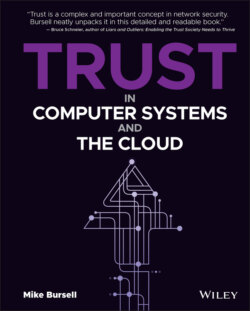Читать книгу Trust in Computer Systems and the Cloud - Mike Bursell - Страница 24
Reputation and Generalised Trust
ОглавлениеThe Prisoner's Dilemma is not the only type of game covered in the field of game theory. There are many, of which most are two-player games, and most can also have multiple participants (with no theoretical limit). The two-player games serve to give an example of how assurances about future behaviour—what we are referring to as trust relationships—can be formed between two participants.
What about the case for multiple participants? When I set about forming a trust relationship “from scratch”—with no prior interactions—to someone (let us call her Alice), then I do so based on my expectations, biases, and interactions over time. If, on the other hand, somebody (we will call her Carol) asks me for information on Alice in order for her to form an initial opinion, and then asks multiple other people who have also formed a trust relationship to Alice for the same or similar information, then something else is happening: Carol is finding out information not first-hand, but based on information from others.
The standard term for this is reputation, and it does not map directly from a trust relationship that Carol has to Alice but is a second-order construct. Carol cannot directly map my views on my trust relationship to Alice, alongside the views of others on their trust relationships to Alice, directly to her trust relationship to Alice: rather, she derives enough information to describe a reputation that she can relate to Alice and use to decide how best to form a trust relationship.
In the Prisoner's Dilemma example, we discussed the best strategic approach but also noted that many humans often end up taking a much more positive approach than would be expected by theoretical analysis. One reason for this may be that humans do not always act rationally—that is, in ways that suggest informed self-interest. One alternative to a self-interested approach is known as generalised trust. Rather than assuming that all trust relationships need to be formed from an initial position of distrust, generalised trust suggests that the default should be to trust, in the absence of any evidence to suggest it would be wise to do the contrary.13 Given our interest in trust for security within computing, this approach may not be a very sensible one: it is much easier to assess risk from the point of view of starting from a position of no trust and build up a trust relationship built on known precepts than to reduce trust. Further, as Brian Rathburn points out,14 such trust relationships typically rely greatly on reciprocity; and given our focus on the asymmetry of trust relationships, we should be wary of relying overly on this approach.
The reputation approach is interesting because rather than having to start her trust relationship to Alice from scratch or with only the tools that she has (her experience, biases, and some expectations), Carol starts with some specific information about Alice that she can use. We can think of this type of information as inputs to the idea of “trustworthiness” proposed by some of the writers we have mentioned when considering human-to-human trust.
What other types of information might we have up front? Another way of looking at this is asking what pressures can be brought to bear on the trustee that allow me, the trustor, to have a high assurance that this will affect the trustee's behaviour in ways that are likely to influence them to act in ways consistent with my expectations. Bruce Schneier writes in detail about this in Liars & Outliers: Enabling the Trust That Society Needs to Thrive.15 He discusses societal pressures, moral pressures, reputational pressures, institutional pressures, and security systems, all in the context of society. Sanctions, punishments, and incentives all fit into this model of trust establishment and management, and reputation is one of the key concepts required to evaluate relationships.
We know in our day-to-day human interactions that reputations can be ill-formed or unfairly earned and also that they can change significantly over time. We will look at indirect trust relationships in Chapter 3, “Trust Operations and Alternatives”, and at the importance of time in Chapter 7, “The Importance of Time”, but another point arises from reputations: over the many years that humans have grown into larger and larger groups, creating societies and forming organisations, reputations are important for another type of trust relationship. This is the area on which Schneier spends much attention, as evidenced by his chapter headings on organisations, corporations, and institutions, and which we can broadly label institutional trust.
